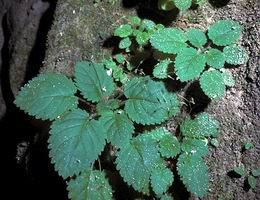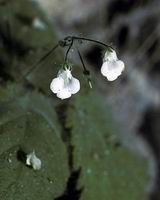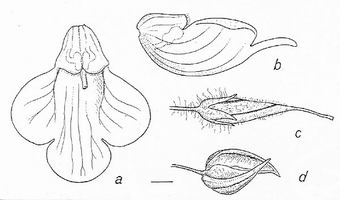

Penins. Malaysia, Pahang, Gua Luas, phot. A. Weber (1986)
Full name and orig. publication: Spelaeanthus R.Kiew, A.Weber & B.L.Burtt, Beitr. Biol. Pflanzen 70 (2-3): 401 (26 Nov. 1998, "1997").
Etymology: From the σπηλαιον, spēlaion = cave, and ανθος, anthos = flower; “flower of the cave”.
Synonyms: -
Infrafamilial position: Didymocarpoid Gesneriaceae - "Advanced Asiatic and Malesian genera" (Weber 2004).
Description: Small saxicolous herbs. Stem thin, to 10 cm long, ascending, with long sticky hairs. Leaves opposite, those of a pair subequal, loosely tufted, petiolate, lamina ovate, margin serrate with blunt teeth, grey-green, with sticky hairs. Cymes with slender peduncle and few to many flower pairs. Sepals free to base. Corolla small, pure white, shaped like a shallow bowl, limb bilabiate, with rounded lobes, mouth wide open. Stamens 2, enclosed within the corolla. Ovary conical. Nectary absent. Capsule straight to slightly twisted, thin-walled. Seeds with reticulate testa.
Chromosome number: 2n = 16.
Type and only species: Spelaeanthus chinii R.Kiew, A.Weber & B.L.Burtt
Species names (incl. publication and synonyms): See Skog, L.E. & J.K. Boggan. 2005: World checklist of Gesneriaceae: http://persoon.si.edu/Gesneriaceae/Checklist.
Distribution: Malay Peninsula (Pahang), Batu Luas.
Ecology: On damp rock faces, esp. at the entrance of limestone caves.
Notes: The genus is superficially similar to Emarhendia and Senyumia, all growing in and around limestone caves in Peninsular Malaysia.
Bibliography: See Skog, L.E. & J.K. Boggan. 2005. Bibliography of the Gesneriaceae. 2nd edition: http://persoon.si.edu/Gesneriaceae/Bibliography.
Illustrations:
 |

|
Spelaeanthus chinii R. Kiew, A. Weber & B.L. Burtt
Penins. Malaysia, Pahang, Gua Luas, phot. A. Weber (1986) |
 |
Spelaeanthus chinii R. Kiew, A. Weber & B.L. Burtt
Kiew et al., Beitr. Biol. Pflanzen 70: 394, fig. 8 (1998) |
last modified: 2008-02-26